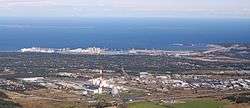Muuga Harbour
| Muuga Harbour | |
|---|---|
 Aerial view of the Muuga Harbour | |
| Location | |
| Country | Estonia |
| Location | Viimsi and Jõelähtme parishes and Maardu |
| Coordinates | 59°29′30″N 24°57′30″E / 59.49167°N 24.95833°ECoordinates: 59°29′30″N 24°57′30″E / 59.49167°N 24.95833°E |
| Details | |
| Opened | 1986 |
| Operated by | Port of Tallinn |
| Type of harbor | cargo port |
| Size of harbor | 7.52 square kilometres (2.90 sq mi) |
| Land area | 5.242 square kilometres (2.024 sq mi) |
| Available berths | 29 |
| Statistics | |
| Annual container volume | 251,738 TEU's (2013) [1] |
|
Website www | |
Muuga Harbour (Estonian: Muuga sadam) is the largest cargo port in Estonia, located on the southern coast of the Gulf of Finland, 13 kilometres (8.1 mi) northeast of the capital Tallinn, in Maardu. The harbour is administrated by Port of Tallinn, the biggest port authority in Estonia. Muuga Harbour is one of the few ice-free ports in northernmost Europe and among the deepest —up to 18 metres (59 ft) — and most modern ports in the Baltic Sea region. The cargo volume handled accounts for around 80% of the total cargo volume of Port of Tallinn and approximately 90% of the transit cargo volume passing through Estonia. Nearly 3/4 of cargo loaded in Muuga Harbour includes crude oil and oil products, but the harbour also serves dry bulk (mostly fertilizers, grain and coal) and other types of cargo.
The usual annual cargo traffic in the seaport is about 20–30 million tons.
The harbour covers an area of 5.24 square kilometres (2.02 sq mi) on land and 7.5 square kilometres (2.9 sq mi) of water. Besides Maardu, the seaport also occupies land in the villages of Muuga and Uusküla.
There are 29 quays with a total length of 6.4 km (4.0 mi). The maximum depth is 18.0 m (59.1 ft). The largest tonnage of ship that can be accommodated is 300 by 48 metres (984 by 157 ft).
There are 6 liquid bulk terminals, container, grain, coal, steel and a dry bulk terminals located in the port.
 Grain terminal
Grain terminal The headquarters
The headquarters First ship at the Muuga Coal Terminal
First ship at the Muuga Coal Terminal
See also
References
- ↑ "Container turnover of Transiidikeskus grew by 12% in 2013". The Baltic Course. 16 January 2014. Retrieved 9 July 2014.
External links
- Muuga Harbour at Port of Tallinn's website
- Muuga Container Terminal
- Muuga Coal Terminal
- Muuga Grain Terminal